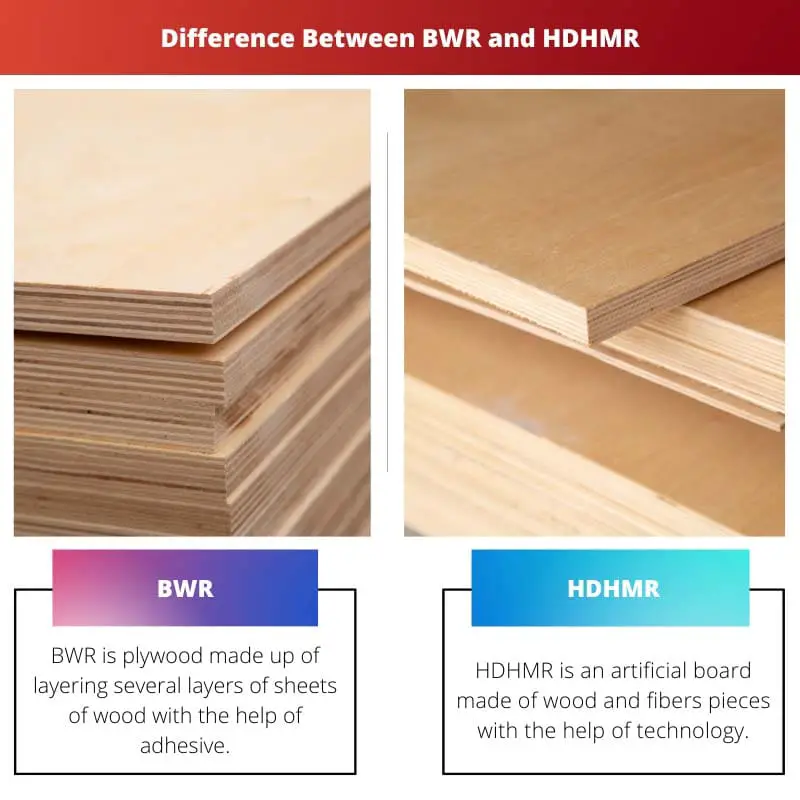Plywood’s are the most common material used for making furniture, architects, and decorating pieces. Humans have evolved and come a far way.
In ancient times, the use of woods was made for various works. Similarly, nowadays, plywood are designed and used in our daily life. Many types of plywoods are used according to the need and choice.
Key Takeaways
- BWR (Boiling Water Resistant) plywood suits exterior applications, while HDHMR (High-Density, High Moisture Resistant) boards excel indoors.
- BWR plywood demonstrates better resistance to water and moisture than HDHMR boards.
- HDHMR boards offer higher density and strength, making them ideal for furniture and cabinetry.
BWR vs HDHMR
BWR stands for Boiling Water Reactor. This is a type of nuclear reactor in which water is allowed to boil in the reactor core. HDHMR stands for High-Density Homogeneous Metal Reactor. This is a type of nuclear reactor that uses metal fuel instead of traditional uranium or plutonium fuel.

BWR (Boling Water Resistance” is one type of plywood resistant to water. They are used to make furniture, outdoor decors, as it is waterproof.
They are used to make all the furniture that is prone to moisture. Compared to other normal plywood, BWR plywood is a better option as it provides features like waterproof, pest and termite-proof.
HDHMR (High-Density High Moisture Resistance) is a processed combination of fiber pieces and woody materials. They are used for all the furniture which are water-prone too.
These types of ply are ideal for kitchen spaces which are most of the time wet. It does not break or wrap like others due to moisture.
Comparison Table
| Parameters of Comparison | BWR | HDHMR |
|---|---|---|
| Definition | BWR is plywood made up of layering several layers of sheets of wood with the help of adhesive. | HDHMR is an artificial board made of wood and fibers pieces with the help of technology. |
| Density | 600-750 kg/m3 | 850 kg/m3 |
| Grades | IS:303 | IS:710 |
| Thickness | Comes in various size: 2.5 mm to 25 mm | Comes in various sizes: 3 mm to 25 mm |
| Affordability | Comparatively inexpensive due to less durability | Comparatively expensive due to durability |
What is BWR?
BWR (Boiling Water Resistance) is plywood that is resistant to water. They are mainly made up of phenolic resins (synthetic polymers).
BWR plywood can be utilized indoors, exterior, and semi-outdoor in humid environments as an exterior plywood grade. The waterproofing properties of BWR plywood are due to the use of A-grade phenolic resins or phenol formaldehyde adhesive in its production.
It can withstand water better than MR or moisture-resistant plywood of the Interior grade. IS:303 is the Indian Standard standard number for BWR plywood.
It has a density of 600-750 kg/mg3. Woodwork is the most significant part of any interior project. BWR is coming inexpensive and has a shelf life of around ten years, which well used can go up to 15 years.
BWR plywood has zero surface core gaps, is warp-free, and has stronger bonding. These are used to create kitchen cabinets and furniture.
This plywood is employed in bathroom wall units and storage cabinets. BWR is termite-proof plywood because the core layer is treated with several hazardous chemicals utilizing VPI technology.
The plywood is made of several layers of wood which is then stuck together to form a single. Plywood has evolved as a material in the interior design business, with various varieties, grades, thicknesses, and sizes.
BWP and BWR plywood are the two most frequent varieties utilized in interior design for ornamental and aesthetic purposes.
What is HDHMR?
HDHMR (High-Density High Moisture Resistance) is a processed strong board made of small woody wastes and fiber pieces. All the materials are pressed together to make a strong board with high density.
Due to their sturdy nature, HDHMR ply is preferred for home and furniture.
It has a greater density than other plywood. These boards are preferred due to their less exposure to pests and termites. So, it can’t get damaged easily and can withstand higher climatic conditions.
It is a good substitute for the wooden ply due to its high resistance to moisture, climatic conditions, termites, and pests. Pieces of hardwood are used to make a high density of the board.
HDHMR boards are found in bathroom cabinets, modular kitchens, wardrobes, living room partitions, and much more. It is completely water-resistant, termite, borer, and fungus resistant.
Many brands can give up to 5-7 years of warranty. Action Tesa was the first brand that brought up this board in the market, which provides seven years of guarantee.
HDHMR boards are found in bathroom cabinets, modular kitchens, wardrobes, living room partitions, and much more. It is completely water-resistant, termite, borer, and fungus resistant.
It also comes up with a high screw holding capacity. One cannot mark a screw in the board with his hand’s machine power is required to fix a screw in it.
Main Differences Between BWR and HDHMR
- BWR is resistant to the water and moisture content at a certain period, whereas HDHMR is resistant to moisture and pests for an extended period.
- BWR is directly obtained and made by layering sheets above another with an adhesive. HDHMR board is created artificially by the technology using wooden and fiber pieces.
- The density of BWR plywood is 600-750 kg/m3, while the that of HDHMR board is 850 kg/m3.
- BWR plywood has IS:303 grade, whereas HDHMR board has IS:710 standard.
- BWR is resistant to pests, termites, and moisture. HDHMR gives the features like resistance to pest and termite, borer, moisture, and screw proof.
- BWR plywood may get damaged after exposure to moisture after a certain period. HDHMR will not get damaged as it has a warranty on the board.

- https://www.sciencedirect.com/science/article/pii/S095965261933046X
- https://onlinelibrary.wiley.com/doi/abs/10.1002/pi.4990290103
